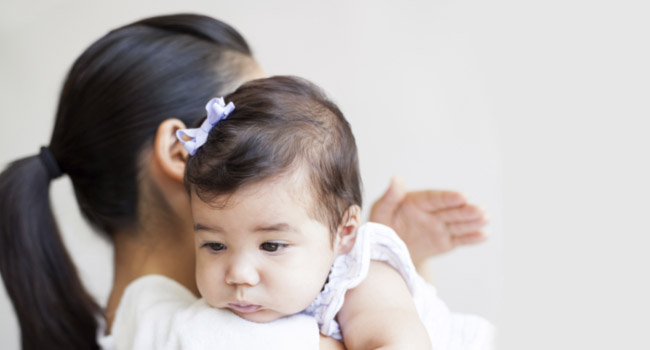Infant reflux and spilling in your baby

It can be a messy business, but spilling or infant reflux is normal in most babies and normally occurs after a feed. While it can look like their whole feed has just been brought up, spilling normally happens because they’ve consumed more milk than their stomachs can fit.
Since spilling is the passive bringing up of what your baby has just swallowed during a feed, they’ll tend to remain contented. In this way it’s different to vomiting, where the stomach muscles contract. At times it can feel like their whole feed has just been brought up, but this is rarely the case.
For most infants spilling is just an occasional incident after a large feed and will ease by the time your baby is 12-14 months of age. This is when their digestive system matures and the ring of muscle at the bottom of the oesophagus is more fully developed therefore preventing the regurgitation.
Here’s some practical advice that can help with any excessive spilling:
- Hold your baby upright for a period of time after their feed
- Try not to over feed your baby. Watch for any cues as some babies do prefer to have smaller feeds more often
- During a feed, wind your baby regularly either over your shoulder or sitting upright on your knee
- Ensure that you’re using a correct teat if bottle feeding and try using a slower flowing teat (there are different teats that are appropriate for different ages)
- Try not to worry too much. Some babies are just more ‘spilly’ than others. So as long as they’re content and gaining weight at a healthy rate, it’s more of an inconvenience to you than a concern for your baby
- Keep a muslin cloth on you at all times!
Understanding Gastro-oesophageal reflux disease (GORD)
While its symptoms are very similar to normal infant reflux, GORD is a more serious, long-term condition that can lead to an irritable and unhappy baby.
Babies with GORD will show persistent vomiting and regurgitation (more than 5 times per day), feeding difficulties, difficulty swallowing, abdominal pain and when particularly severe, poor weight gain and respiratory symptoms.
GORD occurs when the ring of muscle at the bottom of the oesophagus relaxes more than normal. This allows stomach contents to travel up the oesophagus, irritating the lining and causing pain in the process.
In the same way that spilling should improve with age, GORD becomes less of a problem as the muscles in the oesophagus strengthen and the stomach capacity increases.
But if you have any concerns about your baby and how much they’re spilling after a feed – or any irritability and pain they’re experiencing – it’s best to speak to your health professional. They’ll be able to help you out with what’s needed.
It’s also worth getting in touch with your health professional immediately if your baby:
- Is coughing, gagging and having trouble swallowing during a feed
- Is persistently projectile vomiting
- Has bile (which is green and watery) in their vomit
- Is frequently crying, irritable, or unhappy
- Is frequently arching their back or drawing their legs up to their tummy during or after a feed, suggesting abdominal pain
- Has wheezing episodes
- Has bad breath
- Is not regularly gaining weight
Some deeper reading
Ministry of Health Food and Nutrition Guidelines for Healthy Pregnant and Breastfeeding Women – A Background Paper 2006.
Best Practise Advocacy Centre New Zealand - Irritable infants reflux and GORD Accessed 7th December 2015.
Gastric Reflux Support Network New Zealand. Crying over spilt milk - Accessed 7th December 2015.
National Health Service (NHS). Reflux in babies - Accessed 7th December 2015.